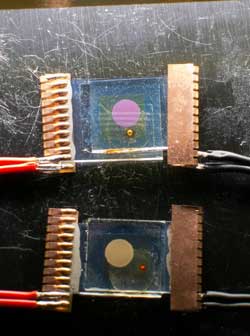Towards low-cost solar cells based on abundant metals

Comparative testing of ruthenium and zinc dye-sensitized solar cells.<br>(Photo: University of Basel/Edwin Constable)<br>
Many technologies are actively under investigation, but a neglected aspect is the sustainability of the material requirements. A highly efficient process based on extremely rare materials is unlikely to enter the mainstream. In an article in the flagship journal Chemical Communications, chemists of the University of Basel describe a paradigm-shifting approach to sustainable and renewable photovoltaic devices.
Dye-sensitized solar cells (DSCs) consist of a semiconductor, titanium dioxide, which is coated with a colored dye. The dye absorbs sunlight and injects an electron into the semiconductor. This is the primary event leading to the photocurrent. Researchers Nik Hostettler and Ewald Schoenhofer in the group of Professors Ed Constable and Catherine Housecroft from the University of Basel have made two breakthroughs. Firstly, they have developed a new strategy for making and attaching colored materials to the surface of titanium dioxide nanoparticles and, secondly, they have shown for the first time that simple compounds of the readily available metal zinc may be used. Project Officer Dr Biljana Bozic says that the key discovery was finding a method for the simultaneous synthesis of the dye and its attachment to the semiconductor surface.
Colorful dyes from gray zinc
The discovery that zinc dyes can be used is most unexpected. Constable states that most chemists consider zinc to be a “boring” element, as most of its compounds are colourless. However, in course of other work related to next-generation lighting devices, his team discovered new highly-colored organic compounds that could bind to zinc to give new coloured materials. Although the devices are not yet particularly efficient, this observation opens the way to new generations of DSCs with hitherto unconsidered types of dyes.
Conventional DSCs use ruthenium dyes, but ruthenium is very rare and expensive (3,500 Swiss Francs/2,990 Euro per kilogram). Recently, this research team demonstrated that dyes from abundant and relatively inexpensive copper (7.5 Swiss Francs/6.3 Euro per kilogram) were effective in DSCs and the extension to cheap zinc (1.8 Swiss Francs/1.5 Euro per kilogram) compounds further increases the sustainability of the materials science. “This is a significant step towards our dream of coupling photovoltaics and lighting in an intelligent curtain which can store solar energy during the day and function as a lighting device at night. This is at the core of our ERC research programme Light-In, Light-Out”, Ed Constable comments.
Full bibliographic information
Biljana Bozic-Weber, Edwin C. Constable, Nik Hostettler, Catherine E. Housecroft, Ralf Schmitt and Ewald Schönhofer
The d10 route to Q1 dye-sensitized solar cells: step-wise assembly of zinc(II) photosensitizers on TiO2 surfaces
Chemical Communications (2012) | doi: 10.1039/c2cc31729j
Media contact
Professor Edwin C. Constable, University of Basel, Department of Chemistry, Tel: +41 (0)61 267 1001, sec: +41 (0)61 267 1022, E-mail: Edwin.Constable@unibas.ch
Media Contact
All latest news from the category: Materials Sciences
Materials management deals with the research, development, manufacturing and processing of raw and industrial materials. Key aspects here are biological and medical issues, which play an increasingly important role in this field.
innovations-report offers in-depth articles related to the development and application of materials and the structure and properties of new materials.
Newest articles

NASA: Mystery of life’s handedness deepens
The mystery of why life uses molecules with specific orientations has deepened with a NASA-funded discovery that RNA — a key molecule thought to have potentially held the instructions for…

What are the effects of historic lithium mining on water quality?
Study reveals low levels of common contaminants but high levels of other elements in waters associated with an abandoned lithium mine. Lithium ore and mining waste from a historic lithium…

Quantum-inspired design boosts efficiency of heat-to-electricity conversion
Rice engineers take unconventional route to improving thermophotovoltaic systems. Researchers at Rice University have found a new way to improve a key element of thermophotovoltaic (TPV) systems, which convert heat…



